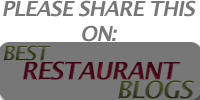Salmon is one of the least understood items on most restaurant menus. Servers are often unaware of what type of salmon is served out of their kitchen. Even more commonly servers are unaware of the unique selling points of the species they offer. This is problematic because premium salmon can warrant a premium price. It is the responsibility of a great server to be able to explain the benefits of the salmon they serve to be able to justify the premium price in the minds of their guests.
Last week’s post on wild caught versus farm-raised salmon provides a good background for understanding this post. Rather than trying to list every type of salmon, I will focus on the species most commonly caught and served in North America. Want to know about a different species or name? Leave a comment below.
Here are the four most common types of salmon you may encounter:
Atlantic Salmon (photo) (nutrition facts)
Atlantic salmon is almost exclusively farm-raised in North America. It is also primarily raised on the Pacific coast of Canada. Early Norwegian immigrants brought these fish to the Pacific to open salmon hatcheries. The flavor of Atlantic salmon varies widely depending on the quality of the farm it came from. It tends to be lighter in flavor and color than it’s wild counterparts. Atlantic salmon is on several environmental watch lists due to concerns with the impact on habitats it has been introduced to and the potential of it escaping to breed with existing wild species.  Atlantic salmon represents a majority of salmon in North America with an estimated catch in 2007 of nearly three billion pounds.
Sockeye Salmon (photo) (nutrition facts)
Sockeye salmon is nearly exclusively wild caught. They are found along the Pacific coast from California to Alaska. Some landlocked species are found in lakes and rivers as far East as New York. In recent years sustainability issues with salmon stocks in the continental US have lead to Bristol Bay, Alaska being the primary source for Sockeye where depending on the year up to 30 million Sockeye can be caught. Sockeye represents a true and clean salmon flavor that others are measured against. Sockeye has a cleaner flavor than Atlantic salmon and is less rich tasting than King or Coho. Sockeye represents the largest portion of wild caught salmon in the United States with over 250 million pounds coming from Alaska last year alone.
Coho Salmon (photo) (nutrition facts)
Coho salmon is both farm-raised and wild caught. A vast majority of the farm-raised Coho comes from Chile while most of the wild caught comes from Alaska. In recent years, commercial Coho fishing has been restricted in the continental United States. Coho breed much more rapidly than other wild salmon species. Coho’s flavor is a blend of the Sockeye and Chinook. Coho tastes more rich than a Sockeye, but with a stronger natural flavor than a Chinook. The color is a deep red. Over 27 million pounds of Coho were caught in Alaska last year.
Chinook Salmon (photo) (nutrition facts)
Chinook salmon is most commonly sold under the trade name “King Salmon†in the US. It is the largest of all of the wild salmon species and spends the longest amount of time maturing. Chinooks are almost exclusively wild caught in the US, but recently New Zealand has started producing a significant volume of farm-raised Chinooks. These are the least common of salmons described here and earn fisherman a price nearly four times as high as Sockeye or Coho. The flavor of a Chinook is unmistakable. Buttery, creamy, and rich with little or none of what would be considered a “salmon flavor.â€Â Even people who do not traditionally like salmon enjoy the Chinook due to its rich taste. It is often sold at a premium due to relative scarcity and highly sought after flavor. Over five million pound of Chinook salmon were caught in Alaska last year. This represents approximately 1/600th of the Atlantic salmon, 1/50th of the amount of Sockeye, or 1/5th the amount of Coho catch.
Pink and Keta (chum) salmon also represent a significant portion of the amount of wild salmon caught, but are primarily used for canning. Steelhead and Char are both salmon relatives that I will save for a later Friday posting. Next Friday I will get into the environmental risks of both farm-raised and wild caught salmon. If you want to make sure you don’t miss it, join the facebook fan page.
Be sure and check out the posts next week. I will be doing a four part series Monday-Thursday analyzing the different priorities guests, managers, and corporations balance that affect servers. I think it will be both informative and eye opening. Plus it allowed me to create graphs and I am a huge graph nerd.



Pingback: The Index « Tips on improving your Tips
Pingback: Dr Strange Salmon « Tips on improving your Tips
Pingback: Searches Answered « Tips on improving your Tips